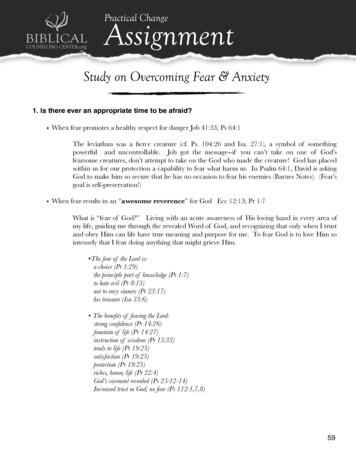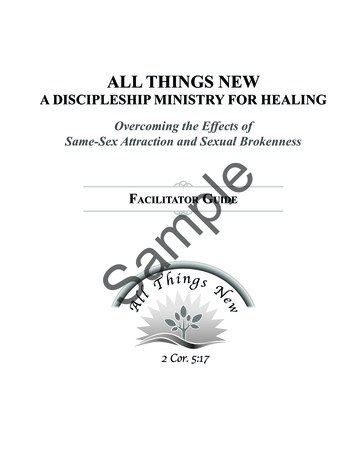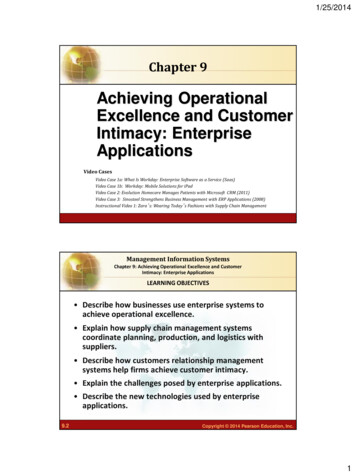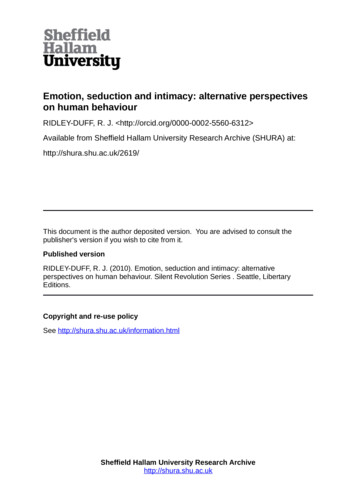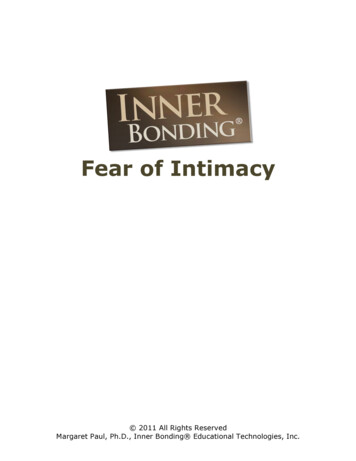
Transcription
Fear of Intimacy 2011 All Rights ReservedMargaret Paul, Ph.D., Inner Bonding Educational Technologies, Inc.
Fear of IntimacyBy Dr. Margaret PaulWe all desire the deeply fulfilling experience of intimacy,yet many people have two fears in the way of intimacy.Discover what these fears are and how to heal them.Emotional intimacy is one of the most wonderful experiences we everhave. Nothing else really comes close to the experience of sharing ourdeepest thoughts and feelings with another, of being deeply seen andknown, of sharing love, passion, creativity, laughter and joy. Theexperience of intimacy fills our souls and takes away our loneliness.Why, then, would someone be afraid of intimacy?It is not actually the intimacy itself that people fear. If people could beguaranteed that intimacy would continue to be a positive experience,they would have no fear of it. What they fear is the possibility ofgetting hurt as a result of being intimate with another.The Two Fears Underlying the Fear of IntimacyMany people have two major fears that may cause them to avoidintimacy: the fear of rejection - of losing the other person, and thefear of engulfment - of being invaded, controlled, and losing oneself.Because many of us have learned to react to conflict with variouscontrolling behaviors - from anger and blame to compliance,withdrawal, and resistance - every relationship presents us with theseissues of rejection and engulfment. If one person gets angry, the othermay feel rejected or controlled and get angry back, give themselvesup, withdraw or resist. If one person shuts down, the other may feelrejected and become judgmental, which may trigger the other's fearsof engulfment, and so on. These protective circles exist in one form oranother in most relationships. When the fears of rejection andengulfment become too great, a person may decide that it is just toopainful to be in a relationship, and they avoid intimacy altogether.Yet avoiding relationships leads to loneliness and lack of emotional andspiritual growth. Relationships offer us the most powerful arena forpersonal growth, if we accept this challenge. So what moves usbeyond the fear of intimacy? 2011 All Rights ReservedMargaret Paul, Ph.D., Inner Bonding Educational Technologies, Inc.
Healing the Fear of IntimacyThe fear exists, not because of the experience itself, but because youdon't know how to handle the situations of being rejected orcontrolled. The secret of moving beyond the fear of intimacy lies indeveloping a powerful loving adult part of you that learns how to nottake rejection personally, and learns to set appropriate limits againstengulfment.When you learn how to take personal responsibility for defining yourown worth, instead of making others' love and approval responsible foryour feelings of worth, you will no longer take rejection personally.This does not mean that you will ever like rejection - it means you willno longer be afraid of it or have a need to avoid it.When you learn how to speak up for yourself and not allow others toinvade, smother, dominate and control you, you will no longer fearlosing yourself in a relationship. Many people, terrified of losing theother person, will give themselves up in the hope of controlling howthe other person feels about them. They believe that if they complywith another's demands, the other will love them. Yet losing oneself isterrifying, so many people stay out of relationships due to this fear. Ifthey were to learn to define their own worth and stand up forthemselves, the fear would disappear.The Inner Bonding process is designed to create a powerful inner adultself, capable of not taking rejection personally and of setting limitsagainst loss of self. Anyone can learn this six-step process and, withpractice, heal fears of intimacy. Through practicing the Inner Bondingprocess, you learn to value and cherish who you really are, and takefull responsibility for your own feelings of worth, lovability, safety,security, pain and joy. When you deeply value yourself, you do nottake rejection personally and you become non-reactive to rejection.When you value yourself, you will not give yourself up to try to controlanother's feelings about you. When you value yourself, you are willingto lose another rather than lose yourself.Start to learn Inner Bonding now! Moving beyond your fears ofintimacy will open you to the deep personal and spiritual growth thatrelationships can provide, and the profound fulfillment and joy thatloving relationships can offer. 2011 All Rights ReservedMargaret Paul, Ph.D., Inner Bonding Educational Technologies, Inc.
The Fear of Engulfment Hides a Fear of RejectionBy Dr. Margaret PaulDo you find yourself giving yourself up in a relationshipand then resenting the other person? Do you fear beingcontrolled in a relationship? Discover the underlyingcause of these issues and what to do about it.Jim was attending his first five-day Inner Bonding Intensive becausehe could not seem to commit to a relationship. He was lonely andwanted to be in a relationship, and he had no trouble meeting womenhe was attracted to, but as soon as he started to really like someone,he would find any number of reasons to back out. In his early 40's, hewas tired of this, but couldn't seem to break out of the pattern.It soon became apparent that Jim was terrified of losing himself in arelationship. He was a very kind-hearted man and enjoyed giving, butinvariably he found himself giving too much - giving himself up. Intime he would feel controlled, engulfed, smothered in the relationship.He would start to feel resentful about giving more than he wasreceiving and would end the relationship. This same pattern happenedover and over.Jim was very aware of the fact that he kept giving himself up inrelationships, but he believed it was because he was attracted tostrong, controlling women. He never found himself attracted to timidwomen who gave themselves up. So he felt stuck.He was stuck because he was operating out of a false belief that hewas giving himself up because the woman was controlling. In fact, herbehavior had NOTHING to do with Jim giving himself up.Jim gave himself up because underneath his fear of engulfment was adeeper fear - a fear of rejection. He feared that if he did not givehimself up and do what a woman wanted him to do, she would rejecthim. His intent in giving himself up was to have control over thewoman not rejecting him. But in giving himself up, he was rejectinghimself, so he would always end up feeling resentful and rejecting thewoman.This pattern would start as soon as a woman became important tohim. As soon as he started to really like her, he would begin to fearlosing her. In order to have control over not losing her, he was willing 2011 All Rights ReservedMargaret Paul, Ph.D., Inner Bonding Educational Technologies, Inc.
to lose himself. But once he started to lose himself, he stopped feelingattracted to her.The underlying issue was that Jim had never learned to handle theloneliness and heartbreak of rejection. Having experienced rejectionearly in his life from his parents, he was terrified of it.As children, none of us can handle rejection well. All of us had to learnprotective ways of handling the pain of rejection. We learned tocomply, resist, get angry, shut down or withdraw in response torejection. We then carried these protections into adulthood, neverlearning healthy ways of managing the pain of rejection.Jim was invariably attracted to women who used anger as their way toprotect against rejection, while Jim continued to use compliance andwithdrawal as his protections.In order for Jim to sustain a healthy relationship, he needed to learn tomanage the pain of rejection. We all need to learn to manage theloneliness and heartache of rejection in order to stay open in arelationship. No matter how good a relationship, there is always goingto be rejection. There is no such thing as a relationship where younever feel rejected.In order to learn to manage the pain of rejection so that he would nolonger give himself up, Jim needed to practice Inner Bonding so thathe would stop abandoning himself in the face of his fear of rejection.He needed to develop a loving Adult who could speak up for him andhelp him to not take rejection personally, as well as who could bring inSpirit to comfort the heartache. Jim needed to practice Inner Bondinguntil he was strong enough to love, which means strong enough tokeep his heart open in the face of rejection, and strong enough to bewilling to lose the other person rather than lose himself.Jim did practice Inner Bonding on a daily basis and he graduallylearned to speak up for himself and not take rejection personally. As aresult, his fear of rejection diminished to the point where he was nolonger willing to give himself up or withdraw in the face of a woman'scontrolling, rejecting behavior. Jim is now happily married and lookingforward to starting the family he always wanted. 2011 All Rights ReservedMargaret Paul, Ph.D., Inner Bonding Educational Technologies, Inc.
Overcoming Fears of IntimacyBy Dr. Margaret PaulThe fear of intimacy is based on the false belief of notbeing good enough. Believing this leads to fears ofrejection and engulfment, which then cause the fear ofintimacy.Sam, age 42, had never been married. It's not that Sam had neverfallen in love. But every time a relationship had started to movetoward commitment, Sam ran.When Sam's loneliness became overwhelming to him, he called me forhelp."I want to be in a relationship, yet every time I get close to someone,I run away. I'm not even sure what I'm so afraid of, but I must beterrified of something!""Sam, what happens inside you when you like someone?" Thefollowing answer and resulting dialogue came out over time, but I'vecondensed it here."I think that if this person really knew me, she wouldn't like me. I doall kinds of nice things for her so she will like me. Then, after a while, Istart to feel trapped and I pull back. She gets upset about my pullingback and I then feel even more trapped. Once she gets mad at me, Istop feeling in love with her. That's when I decide she is not the rightone for me. This has happened over and over.""So the first problem is that you believe that she won't like you whenshe gets to know you. Out of your fear of rejection, you try to controlhow she feels about you by doing nice things for her. But then you feeltrapped and your fear of engulfment - of being controlled by her andlosing yourself in the relationship - kicks in. Then you run. It soundslike your underlying fears of rejection and engulfment are controllingyour life and not letting you share love.""That's exactly right! So what do I do about this?"Sam was operating from core shame - the false belief that there wassomething basically wrong with him. As long as he believed that hewas inherently flawed and unlovable, he would fear rejection. Out of 2011 All Rights ReservedMargaret Paul, Ph.D., Inner Bonding Educational Technologies, Inc.
his fear of rejection, he would give himself up until he felt trapped, andthen he would run.The part of Sam that believed that he wasn't good enough is hiswounded self. The basis of the wounded self in all of us is our coreshame false belief - the belief that we are inherently flawed. Ourwounded self does not know that we are a perfect child of God, anindividual expression of the Divine. Because the wounded self operatesout of false beliefs, rather than from the truth of who we really are, itwants to control how people feel about us. Sam needed to develop aloving Adult part of himself - a part of himself connected to a spiritualSource of love and truth - in order to heal his core shame.The six-step Inner Bonding process is a profound process fordeveloping the loving Adult and for healing the fears and limitingbeliefs of the wounded self. As Sam started to practice Inner Bonding,he slowly developed an Adult self who loved and valued his core Self,his true essence. As he developed this inner sense of personal power,he lost his fear of rejection. He saw that if a woman rejected him, itwas because of her fears rather than because of his inadequacy orunlovability. Because he stopped taking rejection personally, hestopped fearing it.Once he stopped fearing rejection, he stopped giving himself up in hisattempt to control how a woman felt about him. Once he stoppedgiving himself up, he stopped feel trapped and engulfed in arelationship.Over time, by consistently practicing the Six Steps of Inner Bonding,Sam developed a powerful inner loving Adult self and healed his fearsof rejection and engulfment. Sam is now happily married with a childon the way.This did not happen quickly. It took Sam time to heal his false beliefsabout his own adequacy and lovability. It took time to develop apersonal relationship with a spiritual Source of love and truth. It tooktime to be in truth with a woman rather than being "nice" to try tocontrol how she felt about him. It took time for him to feel safe inbeing himself. It took a couple of years of devoted Inner Bondingwork.But if you were to ask Sam whether all the time it took was worth it,he would look at you with shining eyes and a huge grin and you would 2011 All Rights ReservedMargaret Paul, Ph.D., Inner Bonding Educational Technologies, Inc.
feel the joy within him. You would have no doubt that it was worthwhatever time it took. 2011 All Rights ReservedMargaret Paul, Ph.D., Inner Bonding Educational Technologies, Inc.
Margaret Paul, Ph.D., Inner Bonding Educational Technologies, Inc. Fear of Intimacy By Dr. Margaret Paul We all desire the deeply fulfilling experience of intimacy, yet many people have two fears in the way of intimacy. Discover what these fears are and how to heal them. Emotional intima

